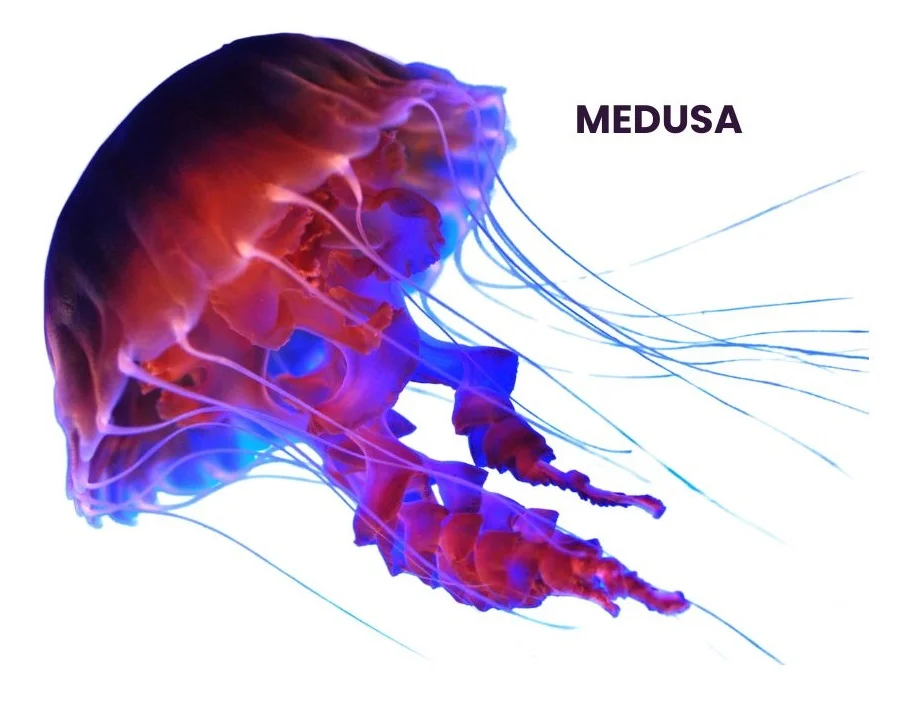Medusa, or Jelly-fish, is a homeopathic remedy derived from the marine creature known for its gelatinous structure and tentacles that can sting.
In homeopathy, it is primarily used to treat conditions characterized by severe swelling and skin eruptions, among other symptoms.

Table of Contents
ToggleSOURCE INFORMATION
Scientific Classification
- Kingdom: Animalia
- Phylum: Cnidaria
- Class: Scyphozoa
- Order: Semaeostomeae
- Family: Ulmaridae
- Genus: Medusozoa
- Species: Several species under the genus Medusa
Origin and Historical Facts
- Jelly-fish are found in marine environments worldwide, particularly in coastal waters.
- They have a long history of use in traditional medicine, including homeopathy, for their unique therapeutic properties.
DRUG PATHOGENESIS
Medusa affects primarily the skin and lacteal glands in females. It is known for causing:
- Severe swelling (œdema) of the face, including eyes, nose, ears, and lips.
- Numbness, burning, and pricking heat sensations on the skin.
- Vesicular eruptions, especially on the face, arms, shoulders, and breasts.
- Nettlerash (similar symptoms to those caused by Apis, Chloral, and Dulcamara).
KEY CHARACTERISTICS
- Facial oedema: Pronounced swelling of the entire face, involving eyes, nose, ears, and lips.
- Skin Symptoms: Numbness, burning sensations, and a pricking heat, often accompanied by a vesicular eruption.
- Female Specific: Noted for its action on lacteal glands, promoting milk secretion after previous failures.
PARTICULAR ORGAN SYMPTOMS
SKIN
- Vesicular Eruptions Medusa is known to cause vesicular eruptions on specific areas of the skin, including:
FACE
- Vesicles may appear on the face, typically accompanied by swelling (oedema) of the entire face, including the eyes, nose, ears, and lips.
ARMS, SHOULDERS, AND BREASTS
- These areas may also develop vesicular eruptions, characterized by small fluid-filled blisters or vesicles.
- The eruptions are often itchy and can be sensitive to touch.
- The vesicles may vary in size and may be associated with burning or pricking heat sensations on the affected skin.
- This symptomatology aligns with Medusa’s affinity for causing skin reactions akin to nettle rash, where there is intense itching and discomfort.
FEMALE
- Stimulates Lacteal Gland Function In females, Medusa has a specific action on the lacteal glands, which are responsible for milk production:
- Post-Childbirth: It is noted for its ability to stimulate milk secretion in lactating women, particularly after childbirth.
- This effect is beneficial for women who have experienced difficulties with milk production in previous pregnancies or postpartum periods.
The stimulation of lacteal glands by Medusa helps promote the flow and production of breast milk, addressing lactation issues that may arise due to various factors.
MODALITIES
- Worse: Symptoms aggravated by factors such as heat or warmth.
- Better: Conditions may improve with cool applications or exposure to cool environments.
WHAT ARE MODALITIES IN HOMOEOPATHY?
RELATIONSHIP WITH OTHER DRUGS
Compare
- Pyrarara, Physalia (for urticaria and skin eruptions).
- Urtica, Homar, Sepia (for various dermatological conditions).
DOSE
- Medusa is typically used in homeopathic potencies, commonly ranging from 6C to 30C.
Frequently Asked Questions
What conditions is Medusa used for?
- Medusa is used primarily for severe facial swelling (oedema), skin eruptions, and promoting lacteal gland function in females.
How should Medusa be taken?
- It is generally taken in homeopathic potency, as prescribed by a qualified practitioner based on individual symptoms.
Are there any specific side effects of using Medusa?
- In homeopathic dilutions, side effects are rare.
- However, consult a practitioner if symptoms worsen or new symptoms arise.
Can Medusa be used alongside conventional medications?
- Yes, it can be used alongside conventional treatments.
- However, inform your healthcare provider about all medications being used to avoid interactions.
Meaning of Difficult Words
- Oedema: Swelling caused by fluid retention in tissues, leading to puffiness or bloating, particularly noticeable in the face and limbs.
- Numbness: Lack of sensation or feeling in a part of the body, often described as tingling or loss of sensitivity.
- Vesicular: Characterized by vesicles, which are small fluid-filled sacs or blisters that can appear on the skin.
- Nettlerash: Also known as urticaria, it is a condition characterized by raised, itchy bumps or hives on the skin, often caused by an allergic reaction or irritation.
- Lacteal Glands: Glands responsible for producing milk in mammals, specifically referring to the mammary glands in females.
This overview provides a comprehensive understanding of Medusa as a homeopathic remedy, highlighting its indications, characteristics, and usage guidelines.
